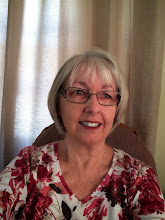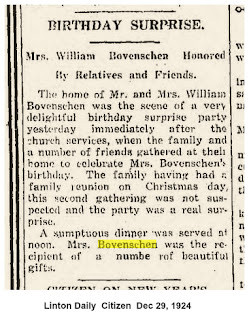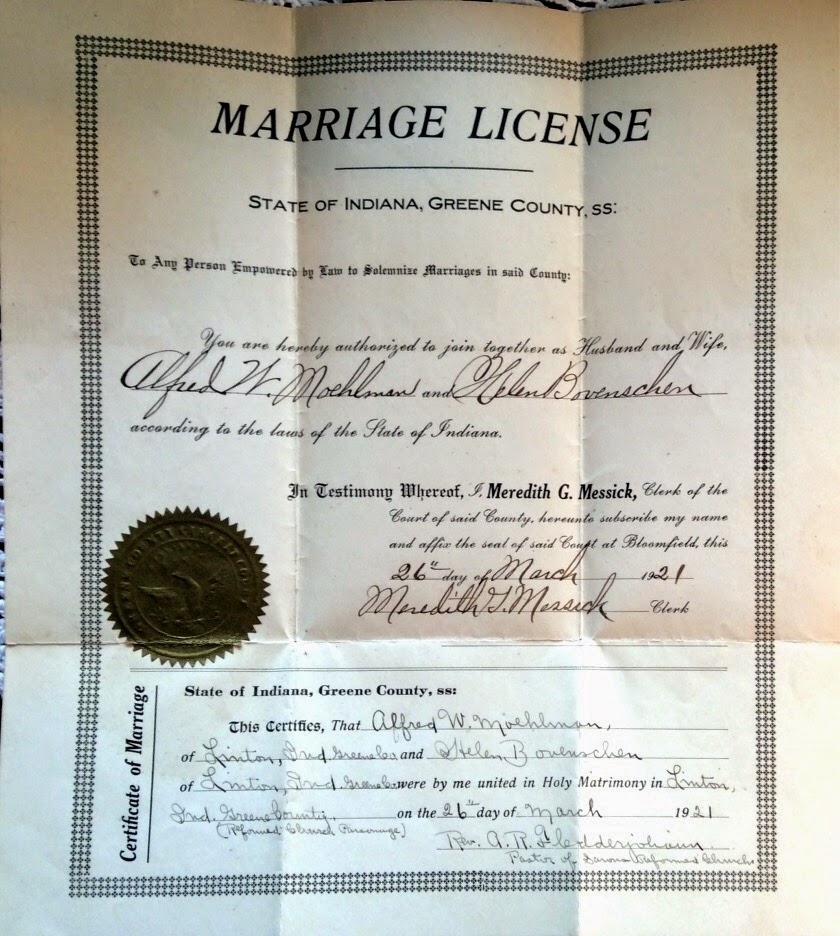Amy Johnson Crow at No Story Too Small has a weekly challenge to write the stories of your ancestors. This is week #18 and the suggested theme is WHERE THERE'S A WILL. I am highlighting my great great grandfather WILLIAM HENRY BOVENSCHEN.
William Bovenschen, my great grandfather, was always known as "Will". He was born in Greene county, Indiana in 1866, the son of a farmer who also became a prosperous farmer. Will died in 1947 so I never knew him. However, his son-in-law, my maternal grandfather, wrote quite a bit about Will. Here is are several excerpts that describe the man he knew.
" ..His wisdom in church affairs rarely was challenged because mainly he was just.....There was something about him that appealed to people. At threshing time, corn shredding time, public sales in in town it seems like a gang was always around him and you knew he was around by his hearty laughter. ...I never saw a family more closely knit together than his. After his children were all married, this unity still exited...He loathed idleness ad I often heard him say that you had to keep kids busy and have chores for them to do...It seemed to me he deplored poverty in the sense that where there is a will there is a way. Through hard work and good management he was always financially secure."
 |
The William Bovenschen Family c. 1910 - Sisster back row: Bernice, Grace, Tressa, Anna, Ruth, Helen
Front: Will, Wayne, Sena
from Moehlmann Family Collection |
 |
Bovenschen Siblings c. 1950. Standing: Tressa, Wayne, Anna
Sitting: Bernice, Ruth, Grace, Helen
from Moehlmann Faimly Collection |
 |
William Bovenschen
from Moehlmann Family Collection |
From the writings it is easy to see that Will was a self reliant man. He did not retire or sell the farm and move to town in his later years. According to his son-in-law, Will considered his farm his hobby.
 |
Linton Daily Citizen, 19 June 1947, page 1
from Moehlmann Family Collection |
At age 81, Will is climbing a tree to trim it. In the Indianapolis paper they next day, June 20, he is quoted as saying, .."the next time I will be more careful." Even after being hurt his comment isn't that he will not climb a tree again but rather talking about the next time.
Here are the entries in his son-in-law's diary in days following the fall:
June 18 - 60 degrees at 7am, rained all day, Grandpa to the hospital
June 20 - Mom brought Grandpa's car here. Grandpa improved in early morning. Went to the hospital to see Grandpa.
June 23 - Mom stayed with Grandpa at nite
June 24 - Grandpa's cow to us
June 26 - Mom stayed with Grandpa
June 30 - Grandpa not so good
July 1 - Grandpa worse
July 2 - Grandpa failing
July 3 - Grandpa critical
July 4 - Mom sat up all day and nite with Grandpa
July 5 - Grandpa very low
July 6 - Grandpa died at 1:10 am, funeral arrangements 10 am, flowers taken care of
July 8 - Grandpa's funeral at 2 pm
July 9 - All family to Ruth's to hear Grandpa's will. Heirs met at Aunt Ruth's at night.
July 13 - All heirs met here - appointed me to act as their agent.
In later writings here is how Alfred relates handling of the will:
"The
family gathered at our home and decided to disregard a will that was made
several years before and although the distribution of the estate was possibly
well equalized at the time it was made, the changing condition of time made it
such that a few would benefit more than others, so they asked me to be the
agent and settle the estate. It was a
big job, there were 7 heirs to satisfy. The
Ax & Fry building and the Farms had to be disposed
of. There was the tax angle,
inheritance, federal, state and county. I made trips to Terre Haute and Indianapolis on federal
tax questions. Several trips to Terre Haute to see officials
of the Maumee Colleries Co. to sell the farms for coal. I had to sell the farms on a contract basis
involving five yearly payments which made a long period of procedure before final settlement. We had permission to
farm the land until it was paid for and Uncle Russell helped me on this
phase. Well naturally final settlement
was made with all the heirs. I must say that all the heirs were nice and
didn’t cause any trouble. That is surely
a credit to a fine family."



















































